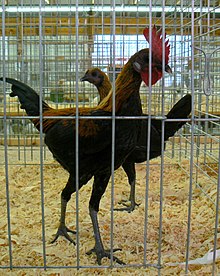Modern Game

Brown red Modern Game pair
|
|
| Conservation status | |
|---|---|
| Country of origin | United Kingdom |
| Standard | PCGB (standard-sized and bantam) |
| Traits | |
| Weight |
|
| Classification | |
| APA | all other standard breeds |
| ABA | Modern Game bantam |
| EE | yes |
| PCGB | hard feather |
|
|
The Modern Game is a breed of ornamental chicken which originated in England between 1850 and 1900. Purely an bird, Modern Game were developed to be most aesthetically pleasing and to epitomize the visual appeal of the gamecock or fighting cock.
After the outlawing of cockfighting in Britain in the mid-19th century, many cockfighting enthusiasts turned to breeding for shows as an alternative poultry hobby, and the Modern Game was developed from crosses of Old English Game and Malays. Despite being classified as game chickens (i.e. of cockfighting derivation) in breed standards, Modern Game were not bred to fight.
Game, as they were then called, were included in nine colours in the Standard of Excellence in Exhibition Poultry, the first edition of the British Poultry Standard, in 1865; a Game bantam was also included. Eight colours of Game were included in the first edition of the Standard of Perfection of the American Poultry Association in 1874.
Today, the ideal show bird should have a body shaped like a flat iron when seen from above, a relatively short back, fine tail, hard feathering, and a very upright carriage. The breed appears in more than a dozen colour variations. The most common being black red, birchen, brown red, duckwing and pile. The colours can be broadly divided into two groups; those with willow-coloured legs and red eyes, and those with black legs and dark eyes. The colour of the skin, comb, and wattles varies from red to mulberry depending on variety, but all have a small single comb. Combs and wattles are required to be dubbed (cut off) to compete in showing in some countries, which reflects their descent from fighting birds.
...
Wikipedia
